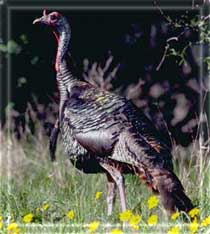|
|
|
Wild Turkey
![]()
There are two species of turkeys in the family Meleagrididae
(order Galliformes). The best known is the common turkey
(Meleagris gallopavo), a native game bird of
North America but widely domesticated for the table. The other
species is Agriocharis (or Meleagris) ocellata, the ocellated
turkey.
Domestication of the common turkey was probably begun by the Indians
of Pre-Columbian Mexico. The birds were first taken to Spain about 1519,
and from Spain they spread throughout Europe, reaching England in 1541.
When the bird became popular in England, the name turkey-cock, formerly
used for the guinea fowl of Islamic (or "Turkish") lands, was transferred
to it. English colonists then introduced European-bred strains of the
turkey to eastern North America in the 17th century. Turkeys were mainly
bred for their beautifully colored plumage until about 1935, after
which the breeding emphasis changed to their meat qualities.
The wild turkey prefers woodlands near water. It eats seeds,
insects, and an occasional frog or lizard. When alarmed it may
run rapidly to cover, but it can fly strongly only for short distances
(about 0.4 km, or 0.25 mile). Formerly diminished under hunting
pressure, M. gallopavo has come back well under various state game
management programs in the United States.
In courtship display the male spreads his tail, droops his wings
and shakes the quills audibly, retracts his head, struts about,
and utters rapid gobbling sounds. He assembles a harem, and each
hen lays 8-15 brownish spotted eggs in a hollow in the ground. The
young (poults) hatch in 28 days.
Races of the common turkey found today in Mexico and in the southeastern and southwestern United States differ slightly in feather markings and in rump colour, but all are basically dark, with iridescent bronze and green plumage. Adult males have a naked, heavily carunculated (bumpy) head that is normally bright red in colour but turns to white overlaid with bright blue when the birds are excited. Other distinguishing features of the common turkey are a long red fleshy ornament (called a snood) that grows from the forehead over the bill; a fleshy wattle growing from the throat; a tuft of coarse, black, hairlike feathers (known as a beard) projecting from the breast; and more or less prominent leg spurs. The male turkey, or gobbler, or tom, may be 130 cm (50 inches) long.

![]()
Foxes
|| Loons || Manatee
Moose || Raven || Turkey ||
Wolves
Main SiteGuide
Avian Critter || Canine Critter
|| Human Critters
Beanie
Critters || Wild Critters
Interests & Hobbies & Links, Oh My!
![]()
graphics/design by me: Papagei Studios